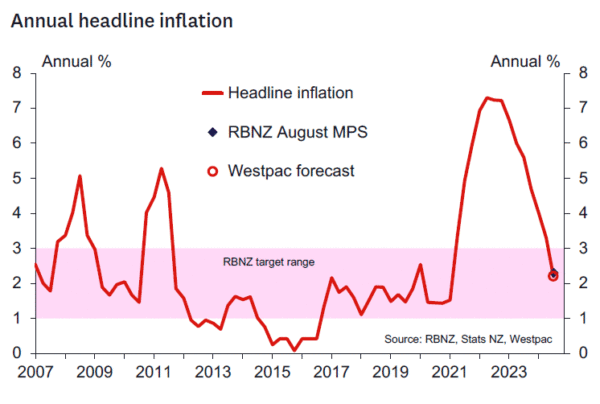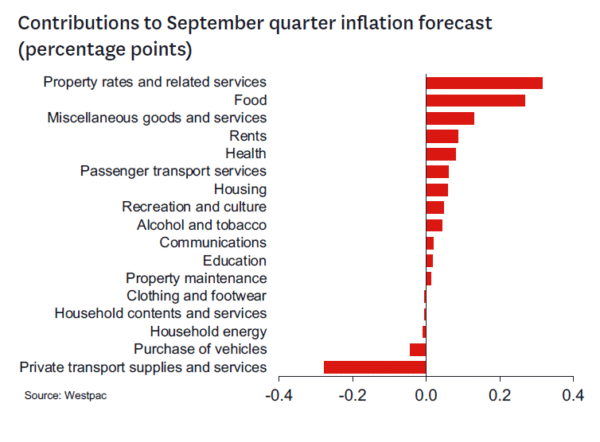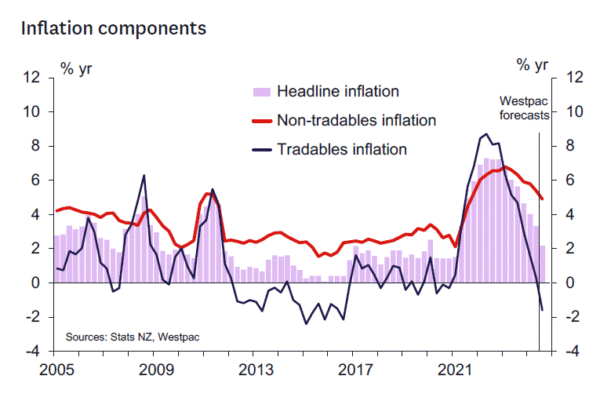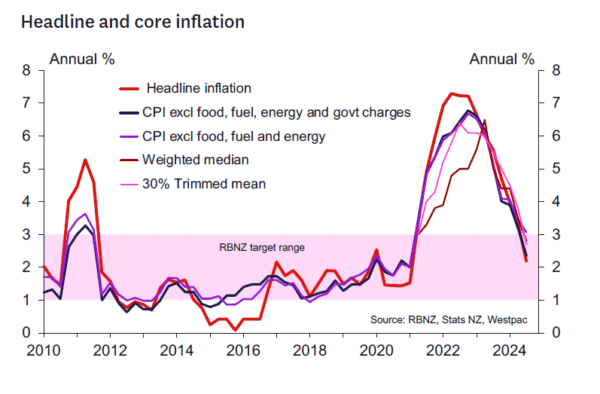- Consumer prices rose by 0.6% in the September quarter. That saw annual inflation fall to 2.2%, the first time it’s been in the RBNZ’s target band since 2021.
- Inflation has been pulled down by a sharp fall in imported prices. Domestic inflation has been easing, but more gradually.
- While there were some large quarter-toquarter swings (in part related to policy changes), the broader trend in inflation is down. Inflation is set to track close to 2% over the coming year.
- We continue to expect a 50bp cut from the RBNZ at their 27 November meeting.
Inflation is back inside the RBNZ’s target band for the first time since 2021.
Consumer prices rose 0.6% in the September quarter. That saw the annual inflation rate fall to 2.2%, down from 3.3% in the year to June.
The result was a little below our forecast and was also lower than the RBNZ’s last published forecast.
What underpinned inflation in the September quarter?
Underpinning September’s rise in consumer prices was another big increase in local council rates (+12.2%) and a large increase in food prices (+1.3%, including a seasonal rise in vegetable prices). There was also an increase in healthcare costs related to the reintroduction of prescription fees, with the price of pharmaceutical products rising 17%.
On the housing front, rents were up 0.9% in the September quarter, leaving them up 4.5% over the past year. Housing construction costs were up only 0.1%, with competitive pressures one factor contributing to the low result.
Balanced against those increases, the September quarter saw a 6.5% fall in petrol prices. There has also been softness in the prices of a range of imported durable consumer goods. Notably, new and used motor vehicle prices were down 0.6% and 2.8% respectively. There has also been softness in apparel prices.
Inflation in the September quarter was also pulled down by the introduction of the FamilyBoost early childhood education rebate scheme which began on 1 July 2024.
- This policy allows eligible families to claim up to 25% of their weekly childcare fees (up to a maximum of $975 every three months).
- Early childhood education costs account for 0.6% of the CPI, and the 22.8% reduction in those costs shaved 0.3ppts off inflation in the September quarter.
- If not for that policy change, the quarterly inflation rate would have been 0.9%.
- This policy change will dampen the annual inflation figures over the next few quarters, before dropping out of the calculations in September next year.
Annual and core inflation: trending back to target.
Of more note than the quarter-to-quarter swings in prices is the continued downtrend in annual inflation, which has been steadily falling for around two years now.
The downtrend in headline inflation is mainly due to the low level of tradables prices (mainly imported retail goods).
- Tradable prices fell by 0.2% this quarter, leaving them down 1.6% over the past year. The drop in tradables inflation has been stark – this time last year annual tradables inflation was running at +4.7%.
- The fall in tradables prices has in part been due to falls in global prices as international supply conditions have improved over the past couple of years.
- The downward pressure on prices has been somewhat amplified by the pressures on household budgets and the related weakness in discretionary spending. That’s resulted in softness in the prices of a range of consumer goods.
Domestic (non-tradable) price pressures have also been easing, but more gradually.
- Non-tradable prices rose 1.3% in the September quarter, with the annual rate slowing to 4.9%. While that’s down from 5.4% last quarter, it’s still well above long-run averages.
- Notably, non-tradables inflation has been pulled down by the change to early childcare costs (If not for that change, annual non-tradables inflation would have been 5.2%). However, the impact of that policy change is balanced against the reintroduction of prescription fees, which had a similar sized impact.
- Under the surface, we are seeing some notable differences in domestic costs. Inflation in service sectors is easing back, consistent with the downturn in economic growth and softening in the labour market. But at the same time, we’re still seeing continued large increases in some non-discretionary expenses, like local council rates. That mix of conditions is likely to continue for some time, meaning that overall non-tradable inflation will remain at firm levels for a while yet.
Even with the ‘stickiness’ in domestic prices, overall inflation is trending down. That was reflected in the various measures of core inflation (which smooth through volatile quarter-to-quarter price movements, and instead track the underlying trend in prices). Most measures of core inflation have been dropping back and are now close to 3%, or in some cases a little below.
- Inflation excluding food, fuel and energy costs eased from 3.4% to 3.1% previously.
- 30% trimmed mean inflation fell from 3.8% to 2.7%
- Weighted median inflation fell from 3.5% to 2.8%
Implications.
Inflation is at long last back in the RBNZ’s target band, and it looks set to track close to 2% over the year ahead. Consistent with that more-contained inflation outlook, we expect that the RBNZ will deliver another jumbo-sized 50bp cut in November, with further but more gradual cuts next year.
But although the RBNZ will now be feeling more comfortable about how inflation is tracking, the underlying details of today’s inflation report highlight some key areas to watch that could be important for the stance of monetary policy.
First, domestic inflation is still elevated, and not just because of items like council rates. That ‘stickiness’ in domestic prices will be important for how far and fast inflation eases, especially with interest rates now moving down.
At the same time, we are seeing weakness in the prices of imported consumer goods and household spending is still weak. With tradable prices heavily influenced by offshore conditions, the RBNZ often tends to de-emphasise surprises on this front in their policy deliberations. However, continued softness on this front would raise the risk of inflation falling below 2% next year.


















